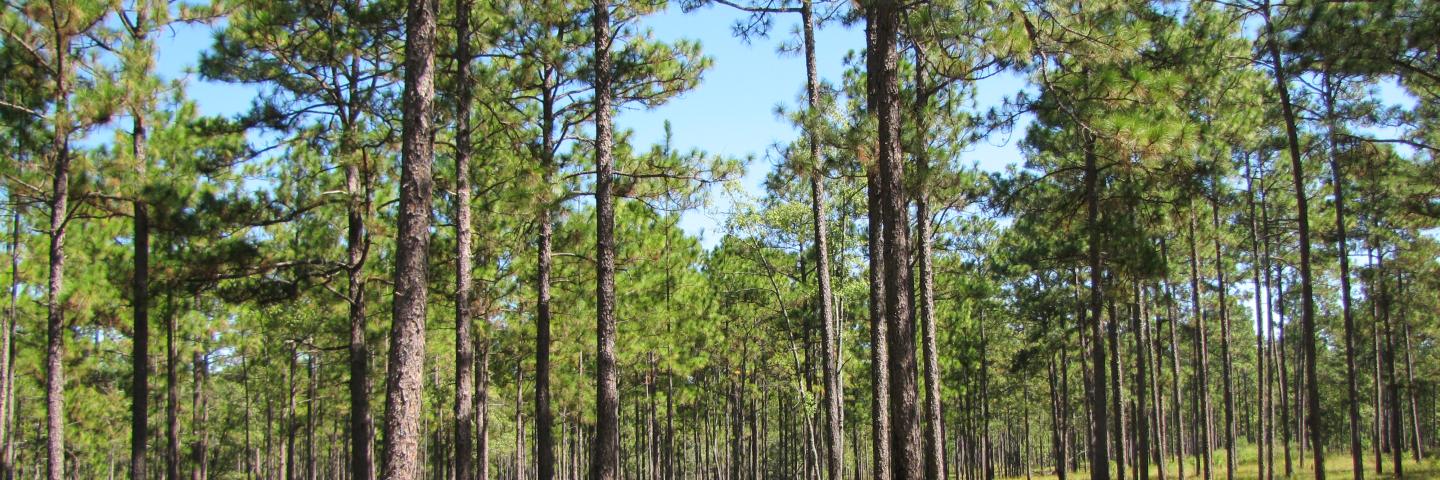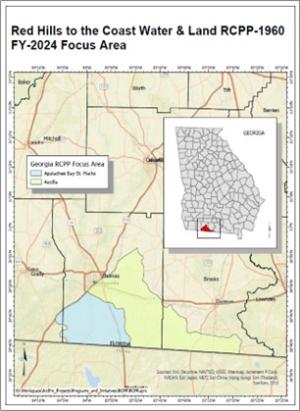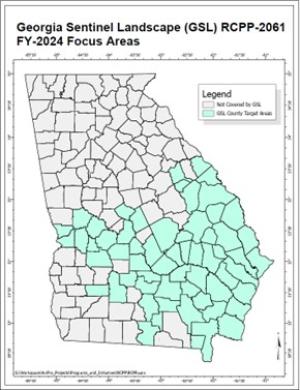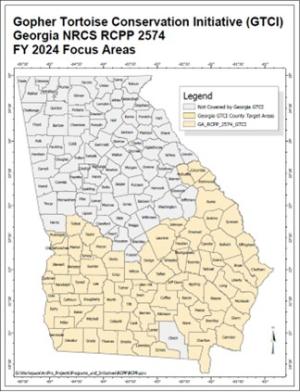USDA-NRCS and Partners Announce Sign-Up for Regional Conservation Partnership Program Projects in Georgia

NRCS in Georgia announces a ranking date for the land management activity portions of the Regional Conservation Partnership Program. Interested producers must apply by November 17, 2023, for their application to be included in this batch of program funding.
Release No.: 02.24
ATHENS, GA, October 2, 2023 — State Conservationist Terrance O. Rudolph, of the U.S. Department of Agriculture’s (USDA) Natural Resources Conservation Service (NRCS), and partner groups, announced today a sign-up for four regionally-focused conservation projects funded through the Regional Conservation Partnership Program (RCPP). Each project has unique objectives and boundaries discussed below, however the ranking date for all eligible producers in these project areas to apply is November 17, 2023.
“RCPP is helping NRCS reach more customers and get more conservation on the ground,” said Rudolph. “By combining resources with our partners and utilizing their networks and expertise, we are building a more climate smart, military ready and overall resilient state.”
RCPP in The Farm Bill
First authorized in the 2014 Farm Bill and reauthorized in 2018’s, RCPP takes a partner-driven approach to conservation that funds solutions to natural resource challenges on agricultural land. By leveraging collective resources and collaborating on common goals, RCPP demonstrates the power of public-private partnerships in delivering results for agriculture and conservation. Currently, NRCS has have 375 active RCPP projects across the country with close to 2,000 partners.
Georgia Projects:
Project ID# 1960 - Red Hills to the Coast

This project is one of 48 RCPP projects across the country that was selected for funding in fiscal year 2020. This project was developed in conjunction with Tall Timbers Research Station and Land Conservancy. The project area includes the entirety of the St. Marks River and Aucilla River watersheds in both Georgia and Florida which contain a considerable number of working lands and forested areas. The focus of the project is to help area landowners implement exemplary land management practices to enhance and steward natural plant communities, wildlife habitats and water resources.
Chief Executive Officer (CEO) and President of Tall Timbers, Bill Palmer stated, "Tall Timbers has a long history of working with private landowners in the Red Hills of Georgia and is excited about this opportunity to partner with NRCS to help landowners in Georgia improve wildlife habitat and water quality through the RCPP project."
The focus areas for this project are portions of Brooks County, Thomas County, and Grady County within the St. Marks River and Aucilla River watersheds.
Land Management Activities
Private Georgia landowners with property in the focal areas within Brooks, Thomas and Grady counties can apply for financial assistance through NRCS land management contracts. Priority practices include but are not limited to prescribed fire implementation, longleaf pine tree establishment, timber stand improvements, invasive plant treatment and wildlife habitat improvement.
Project ID# 2061 - The Georgia Sentinel Landscape

This state project covering Georgia, is one of 48 projects across the country that was selected for funding in fiscal year 2019. This project was developed in conjunction The Georgia Conservancy Inc., working with the Georgia Sentinel Landscape (GSL), which is a partnership also consisting of the US Department of Agriculture, US Department of the Interior, US Department of Defense, the Georgia Forestry Commission, Georgia Department of Natural Resources, The Nature Conservancy, The Georgia-Alabama Land Trust and over a dozen other partners. GSL is one of ten designated Sentinel Landscapes in the nation. Sentinel Landscapes are working natural lands that are important to the National Defense mission. These are places where preserving the working and rural character of key landscapes strengthens the economies of farms, ranches, and forests in addition to protecting the military’s mission.
Georgia Conservancy Inc. President, Katherine Moore, said of the project, “Georgia Conservancy is pleased to work with the NRCS to offer this program to landowners in the Georgia Sentinel Landscape. Prescribed fire brings many benefits to our rare species as well as our populations of quail, deer, and turkey.”
The Georgia Conservancy and partners plan to expand prescribed fire efforts to improve longleaf pine ecosystem management. This funding is a portion of the GSL project, which collectively invests almost $4.3 million, complements Department of Defense Sentinel Landscape activities in Georgia, and supports Georgia’s Gopher Tortoise Initiative goals.
The 60-county focus area for prescribed fire and firebreak related practices for this land management funding announcement include Appling, Atkinson, Bacon, Ben Hill, Berrien, Bibb, Brantley, Bryan, Bulloch, Burke, Camden, Candler, Charlton, Chatham, Chattahoochee, Coffee, Columbia, Dodge, Dooly, Dougherty, Effingham, Emanuel, Evans, Glascock, Glynn, Houston, Irwin, Jeff Davis, Jefferson, Jenkins, Lanier, Laurens, Liberty, Long, Lowndes, Macon, Marion, McIntosh, Montgomery, Muscogee, Pierce, Pulaski, Richmond, Schley, Screven, Sumter, Talbot, Tattnall, Taylor, Telfair, Toombs, Treutlen, Turner, Twiggs, Ware, Warren, Wayne, Wheeler, Wilcox, and Worth.
Land Management Activities
Producers in these Georgia counties looking to improve potential and existing Gopher Tortoise habitat through producer land management contracts involving conservation practices like prescribed burn and firebreaks.
Project ID# 2574 - Gopher Tortoise Conservation Initiative

Led by the U.S. Endowment for Forestry and Communities, the Georgia Gopher Tortoise Conservation Initiative seeks to permanently protect at least 65 viable gopher tortoise populations and 100,000 acres of habitat in Georgia, while managing that land to maintain its habitat value. To date, 61 populations have been protected. Protecting 65 populations will help preclude the need to list the tortoise under the Endangered Species Act. Avoiding an Endangered Species Act listing will benefit the tortoise and its habitat and help maintain a compatible economic environment for Georgia’s forest owners, agricultural producers, and the business community. Military operations in the state will also benefit, as gopher tortoises are found on several military installations.
Because gopher tortoises can thrive in healthy, well-managed forests, one principal element of the initiative is restoration and management of longleaf pine ecosystems.
Land Management Activities
Funding available through this sign-up, if approved, can help pay for prescribed fire and firebreak related practices, planting of longleaf seedlings, tree/shrub site preparation, forest thinning, invasive species removal, and other management practices that restore and maintain healthy longleaf pine forests. An additional benefit of these land management practices is a lowered risk for catastrophic wildfire. This funding is available to landowners who have tortoises on their property or have the potential for tortoise habitat.
The Endowment’s President and CEO, Pete Madden commented, “Working with NRCS, the Georgia Department of Natural Resources, the Orianne Society, and other partners, we are close to the goal of protecting 65 viable gopher tortoise populations in the state. At the same time, we are also maintaining and enhancing forestry operations that are vital for the economy of many rural communities.”
A third partner in the project, the nonprofit, Orianne Society based in Tiger, Georgia, is available to advise landowners at no charge on the suitability of their property for this program. The Orianne Society has expertise in land management practices that restore and maintain gopher tortoise habitat and longleaf pine ecosystems.
Counties in which producers are eligible to apply for this project include Appling, Atkinson, Bacon, Baker, Ben Hill, Berrien, Brantley, Brooks, Bryan, Bulloch, Burke, Calhoun, Camden, Candler, Charlton, Chatham, Chattahoochee, Clay, Coffee, Colquitt, Columbia, Cook, Crisp, Decatur, Dodge, Dooly, Dougherty, Early, Echols, Effingham, Emanuel, Evans, Glynn, Grady, Irwin, Jeff Davis, Jenkins, Johnson, Lanier, Laurens, Lee, Liberty, Long, Lowndes, Macon, Marion, McDuffie, McIntosh, Miller, Mitchell, Montgomery, Muscogee, Pierce, Quitman, Randolph, Richmond, Schley, Screven, Seminole, Stewart, Sumter, Talbot, Tattnall, Taylor, Telfair, Terrell, Thomas, Tift, Toombs, Treutlen, Turner, Ware, Wayne, Webster, Wheeler, Wilcox and Worth counties.
The Orianne Society is also available to advise producers on potential applications for this project. To do so, please contact Caleb Goldsmith cgoldsmith@oriannesociety.org or call 540-750-6319.
Project ID# 2419 - The Working Farms Fund

The Conservation Fund’s, The Working Farms Fund project, will permanently protect significant farmland across the Atlanta metropolitan “foodshed”, and create conservation opportunities for ambitious, diverse farmers to build a resilient regional food system by integrating sustainable farm practices into their production.
The six-county project area in north Georgia will address resource concerns for healthy soil, water quality, wildlife, and protection of farmland in Harris, Jasper, Lamar, Meriwether, Newton, and Rockdale counties.
Land Management Activities
Landowners can apply for assistance through this project to implement land management practices such as wildlife habitat planting, cover crops, high tunnel systems, cross fencing, conservation crop rotation, residue and tillage management, no-till, stream habitat improvement and management, micro-irrigation, conservation cover, heavy use area protection, hedgerow planting, irrigation water management, nutrient management, pasture and hay planting, riparian forest buffer, structures for wildlife, water well, watering facility, stream crossing, and other sustainable farming practices that address soil, water, wildlife, and air quality natural resource concerns.
For More Information
More information on USDA conservation programs, visit https://www.farmers.gov/conservation or https://www.ga.nrcs.usda.gov.
USDA touches the lives of all Americans each day in so many positive ways. In the Biden-Harris administration, USDA is transforming America’s food system with a greater focus on more resilient local and regional food production, fairer markets for all producers, ensuring access to healthy and nutritious food in all communities, building new markets and streams of income for farmers and producers using climate smart food and forestry practices, making historic investments in infrastructure and clean energy capabilities in rural America, and committing to equity across the Department by removing systemic barriers and building a workforce more representative of America. To learn more, visit https://www.usda.gov.

